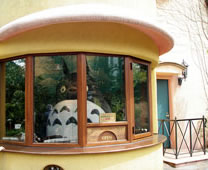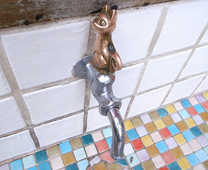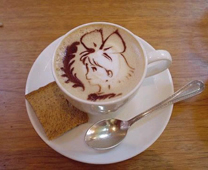
Travel Guide
Introduction
Ghibli Museum is a museum showcasing the work of the Japanese animation studio Studio Ghibli. With this Studio Ghibli finally got a place where fans and admirers can wonder through the world of Ghibli. With the concept of the museum, "Let's become lost children together", the museum houses various exhibits describing the animation process, a play space and movie theater showing a short film. Children are specially catered for, and the Ghibli characters feature in a fun way throughout the museum. There is also a restaurant and gift shops where you can purchase food and souvenirs.
Standing in front of a sign that says “Ghibli Museum, Mitaka”, a very large Totoro welcomes you at the entrance. When looking through the portholes, soot black dust bunnies are there as well. But that’s not the real entrance… Totoro is only standing there to show you where the real entrance is.
Arriving at the entrance of the Museum you enter the entrance room. Here you’ll receive your ticket in exchange for reservation coupons. These tickets are made of pieces of the actual 35mm film prints that were used in theatres. Look up at the ceiling, and you will find it covered in fresco painting. In the centre of a blue sky, there is a shining, smiling sun. Trees stretching up towards the sky are filled with grapes, melons, deliciously ripe fruits, and blossoms which you may never have seen before. If you look carefully, you may see Kiki on her broom, Nausicaa on her glider, or other characters flying through the air.
Taking the staircase downstairs you’ll notice the lovely stained glass windows which are to be found through the entire museum.
After going down the staircase you’ll enter the Central Hall where the wind whistles and the light shines through. Here is a towering open space extending up through the entire height of the museum. In the glass dome at its center, a yellow whale swims in the ocean and the blades of a giant fan rotate overhead. Shining marbles of colored glass are fitted into the ironwork of the stairs and the handrails. Taking in the whole room from bottom to top, you will discover a maze of spiral stairways, bridged passages, and overhanging terraces. This marvellous space transports you into the world of Ghibli and the strange buildings which often appear in its films. Here you can see and feel them for yourself. Please pause before entering the exhibition rooms, and find your own secret favourite spots.
This is one of the five rooms on the first floor called “Where a film is born”. The room seems to belong to someone who has sketching at the desk just a few minutes ago. The room is filled with books and toys. The walls are covered with illustrations and sketches. Hanging from the ceiling are a model of an airplane and a model of a Pteranodon. It’s a place where the owner of the room has stored his favourite things. This room provides lots of inspiration of what will go on to the blank piece of paper on the desk to become the origin of an actual film. After walking through the five rooms, you will get an idea how an animated film is made. With a little bit of an idea and flash of inspiration, a filmmaker struggles with his work and ultimately completes the film.
The Cat Bus is waiting for you in a room on the second floor. It must be everyone’s dream to touch and ride the Cat Bus. In order to make that dream come true, they made a room with an actual Cat Bus. If you remember the Cat Bus from “My Neighbor Totoro”, you have probable dreamed of touching it’s fluffy fur. Now you can do it… or not, because it’s only allowed for kids. Next to the Cat Bus, a bunch of soot-black dust bunnies are waiting for the kids to be played with. They wanted to make the Cat Bus as big as it is in the film, but because it wouldn’t fit, they ended up downsizing him a little bit.
A cozy patio is located between the museum and the café. Surrounded by tiled roofs and colourful flowers, the space is full of sunshine. Looking up from here, you see the vivid orange walls of the café. In the central gazebo, just like in My Neighbor Totoro, there is a hand-pumped well. If you pump it hard, you will be rewarded with fresh, cool water. The well is set in an area full of specially handcrafted ornaments and designs, including a metal hatch cover that looks like a shining face. Just nearby, stacks of firewood can be winched up to the floor above and used to fire the wood-burning stove in the café.
Going up the spiral stairs to the rooftop, you find a open grassy place. The life-size model of Robot Soldier from the animation “Laputa: Castle in the Sky” stands on the rooftop with the pine trees of Inkashira Park as a backdrop.
The museum also has its own place to lunch or buy a snack. Straw Hat Café serves home-style cooking that is made with quality ingredients and prepared form start to finish at the café kitchen. This is a symbolic place for the Ghibli Museum, it can be said to be another exhibit all at its own. Surrounded by some of Mitaka’s rare red pines and set off against the bright orange wall and red window frames of the building that houses it, the deck of the Straw Hat Café provides you with an open outdoors atmosphere where you can relax and enjoy the natural setting of Inokashira Park. Just to the side of the café deck there is a washstand, decorated with colourful tiles and a Kiki’s Delivery Service Jiji faucet handle, so you can wash your hands before mealtime.
One of the highlights of the museum are the exclusive short films which are made especially for the Ghibli Museum. Most of them are shown in the Ghibli Museum's own theater: The Saturn Theater. Each guest to the museum is only permitted to watch the short film once during a single visit. The films are rotated on a monthly basis. The theatre will show only one short film during the month so if there's one that you would really like to see check the schedule before you go.
History
The idea for fans and admirers to wonder through the world of Ghibli was founded by Studio Ghibli director Hayao Miyazaki in 1997. He came up with idea to start a museum that would be “Something interesting that would put visitors at ease. A museum where various things can be discovered. A museum based on a clear and consistent philosophy.”
Planning for the museum began in 1998. Construction started in March 2000, and the museum officially opened October 1, 2001. Miyazaki designed the museum himself, using drawn storyboards similar to the ones he creates for his films. The design was influenced by European architecture, such as the hilltop village of Calcata in Italy. Miyazaki's aim was to make the building itself part of the exhibit, and for the museum to be an uplifting and relaxing experience "that makes you feel more enriched when you leave than when you entered".
 |
 |
 |
| Large Totoro at entrance | Movie characters everywhere | Straw Hat Café |
Travel Advice
Sightseeing
- To make Ghibli Museum, Miyazaki had a clear vision in mind "The building must be put together as it were a film. Not an overbearing flamboyant, gaudy or suffocating building, but a place where people can make themselves at home, especially when it’s not crowded. Something to make people want to touch the things in it. A building through which air and light can freely flow.” Therefore, the museum requires tickets be purchased in advance.
- Tickets for the next month will be open for sell at 10 o'clock on the 10th of each month.
- There are two places to eat at the museum. One is a small hot dog and snack stand, with some tables to sit outside. The other is a very pretty cafe called the Straw Hat. The Straw Hat Café is the Ghibli Museum's only sit-down restaurant. The café serves both cold and hot meals, snacks and desserts. The food is appropriately pretty and cute. The menu is simple and the variety is limited, but almost everything comes from organic farms, is very fresh and nutritious and cooked with loving care and patience. The cafe gets full quickly, so if you are determined to go I would recommend lining up outside early, around 11am if possible, have your early lunch and then see the rest of the museum later.
It was created with the help of a housewife who is a mother of four; Miyazaki wanted the café's food to be "a kind of home cooking".
Facilities
- Photography is forbidden in many places in the museum.
- Free rental for wheelchairs are provided.
- Free lockers are provided.
Visit
| Address | 1-1-83 Simorenjaku, Mitaka-shi, Tokyo (within Inokashira Park) | |
| Phone | 0570-055777 | |
| Admission | Adult: 1,000 yen Senior and Junior high: 700 yen Elementary: 400 yen Child:100 yen |
Adult: over 18 Senior and Junior high: 12 to 17 Elementary: 6 to 11 Child: 4 to 5 Visitors must purchase ticket beforehand. To reserve ticket, go to Loppi (ticket selling machine) at Lawson. |
| Hours | 10:00 to 18:00 11:00 to 19:00 Cafe (entry until 18:00) |
Entrance to the museum is strictly by advance purchase of a reserved ticket which specifies the appointed date and time of the reservation. The entrance hour is 4 times a day. 1st time:10:00. Entry till 10:30. 2nd time:12:00. Entry till 12:30. 3rd time:14:00. Entry till 14:30. 4th time:16:00. Entry till 16:30. |
| Closed | Every Tuesday November 9 to 20 December 28 to January 2 |
|
| Duration | 2 hours | |
| Getting There | By Train 15 minutes walk from Mitaka Station on JR Chuo Line or JR Somu Line. Take 5 minutes ride by Community Bus from Mitaka Station on JR Chuo Line or JR Somu Line to Ghibli Museum bus stop. By Car Take Shuto Expressway to the Takaido exit. It is approximately 30 minutes from exit. |
|
| Parking | No parking available | |

